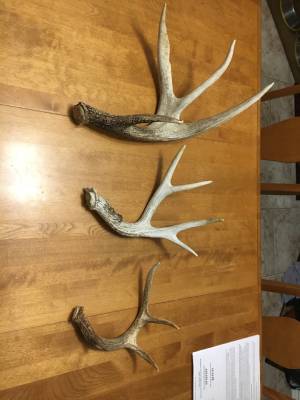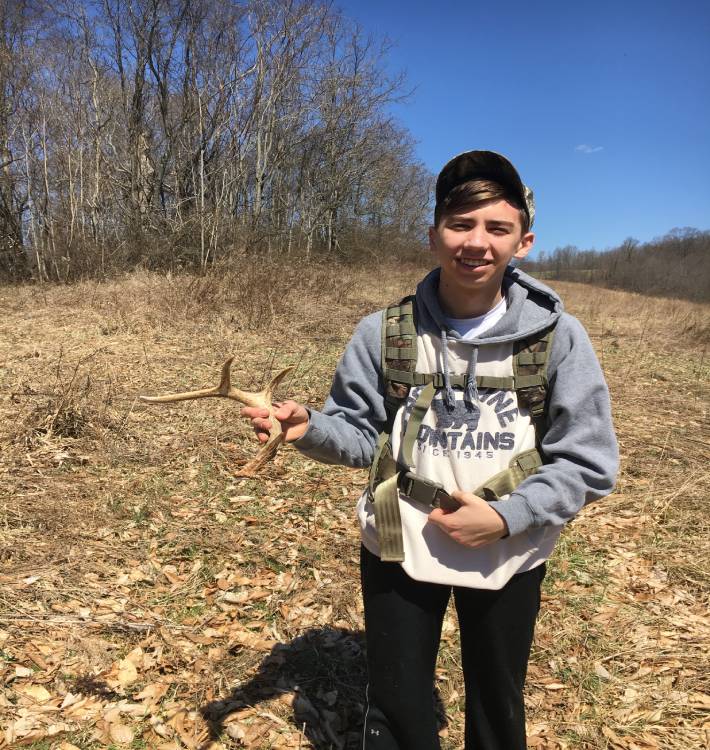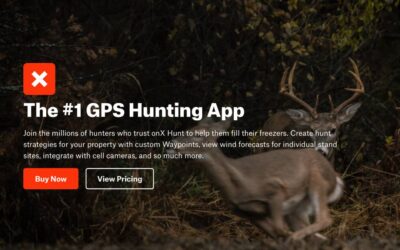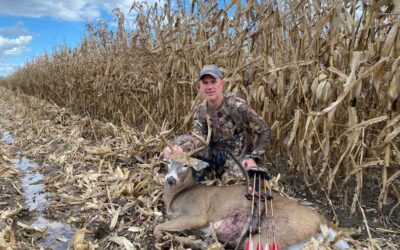Deer are not unique in the way that they shed antlers. Many other species shed antlers on a yearly basis. Because of this, the terminology that you use to describe any species’ headgear matters.
Antlers are bones that will eventually fall off every year and grow back the following year (I will get into the antler cycle soon). Horns, on the other hand, do not fall off. Rather, they grow while they are still connected to the animal’s head.
Species that shed antlers include Whitetail Deer, Blacktail Deer, Couse Deer, Mule Deer, Moose, Elk, Caribou, and Reindeer.
Species that have horns include Cattle, Sheep, Goats, Antelope, and Buffalo.
Why do deer shed their antlers
Deer shed antlers because they need to get the old rack off so next year a new rack can grow. Why does this happen though? Since I am not a scientist, I will say the safe answer. It is the way God created them to be.
Now as simple as that sounds, it means a ton for the whitetail deer hunter. Because if they fall off every year, then a hunter can also help them grow throughout the next year. In the next section of this article, I will go through each part of the year. I will do two things for you at each time of the year.
1 – Explain what is happening to their antlers at the specific time of the year.
2 – Share with you the steps that you can take to help ensure each buck reaches its maximum rack potential!
Life Cycle of a Deer’s Antlers
Spring (April – May)
During the spring, bucks are primarily focused on shedding their winter fur and fat that they added to them so that they could survive the cold winter. Their antlers are in a critical stage of their growth. As food becomes more and more plentiful, bucks are taking that energy and using it for antler growth and stabilizing their body for the summer months.
You can help your bucks max out their full potential by using minerals, salt licks, or feeders. The excess of food and minerals allows them to have a buffet of options and improves their overall health.
In turn, a healthy buck can focus more energy on growing its antlers. The kinds of minerals that you will want to use for maximum antler growth are calcium and phosphorus. These minerals make up 30-35% of the weight of a buck’s antlers when completely hard-horned.
I use Big&J Headrush as a mineral site. This is my first year using the product but so far the deer seem to love it!
Summer (June – August)
In the summer, bucks have a fuzzy layer on the outside of their antlers called velvet. This velvet coating is the driving force of antler growth. It carries thousands of blood vessels that send the proper amount of blood to the actual bone underneath the velvet.
This stage of the antler’s life cycle is a fun stage to watch and will give you a better understanding of how the life cycle of a buck really works. I would suggest getting a trail camera or two so you can observe this stage of antler development. (If you want to learn more about trail cameras, Click Here)
It is worth noting that in the velvet stage, antlers are more susceptible to injury because the bone is not fully developed. If an injury were to occur to the antlers, you may get deformed hard antlers in the fall.
You can continue to run mineral sites, salt licks, and feeders during the summer. Remember as the summer continue to roll through, crop fields will help provide a lot of the food that is available for the deer herd. To spot these velvet bucks, you can also drive around and glass the bean and alfalfa fields. Those crops are high in protein and a hot place for deer to be while they feed in the summer.
Fall (October – December)
Fall is every hunter’s favorite time of the year. Antlers are completely hard, bucks are getting amped up for the rut, and they now get to use those antlers to dominate and area and gain the breeding rights to the first hot doe. Bucks use their antlers to do 3 things in the fall.
-
Fight other bucks.
That may be in the form of sparring which is less aggressive and normally happens at the beginning of October. Or, they can be full-blow aggressive fights to dominate an area and breed a doe. This normally happens in the rut and pre-rut.
-
Make Buck Rubs.
A buck rub is just a way that deer will use their scent glands and antlers to make both a smelling and visual sign to alert other deer that another buck has been in this area. This primarily happens during the pre-rut. Rubs are made on the base of a tree. (If you want to learn more about buck rubs, Click Here)
-
Make Buck Scrapes.
A buck scrape is similar to a buck rub because it all has to do with the scent. However, bucks will also use the scrapes that they make to check if any hot doe has been in the area and may be ready to breed. These scrapes are also made during the pre-rut. Scrapes are made in the dirt and on low-hanging branches of a tree.
Winter (January – March)
 The hunting season has passed and whether you filled your tag or not, there will be some bucks that survive to the next year. So what happens to their antlers? They will eventually fall off of their head. The antler that falls off a deer’s head is known as a shed antler. The causes for this to happen may vary depending on external factors.
The hunting season has passed and whether you filled your tag or not, there will be some bucks that survive to the next year. So what happens to their antlers? They will eventually fall off of their head. The antler that falls off a deer’s head is known as a shed antler. The causes for this to happen may vary depending on external factors.
For example, a severe winter can cause a deer to spend more of its energy on survival than on holding antlers on its head. In that case, premature shedding of antlers may occur. Other external factors that can cause premature antler shedding would be injuries, car accidents, wounds, or anything that requires them to spend more energy on something else besides their antlers.
The best thing that you could do for the deer during this time is to keep updated on where they are currently because deer can migrate or go somewhere else during the winter to get to better resources or warmer conditions.
These wintering spots that deer will use, will often be a good place to look for shed antlers. Antlers will eventually fall off even if you gave the deer every resource that you could.
This is the beauty of the life cycle of shed antlers and antlers in general. I am a firm believer that helping the bucks grow bigger and stronger also makes for a better overall herd. This will ultimately give you some better hunting as well.
Why Hunters Should Care about Shed Antlers
Shed Antlers are a piece of whitetail deer hunting that often gets overlooked by many hunters. Saying like, “Well even if I find the sheds, the buck is still not dead.”, “Why would I spend time walking around the woods looking for shed antlers during the offseason”, or “Shed antlers do not help me kill that deer so what is the point.” Well, all these things are far from the truth. In fact, shed antlers can play a huge role in the future seasons of hunting.
How Shed Antlers can Tell You about the Age of a Buck
 If you only have trail camera pictures of a deer, then it is possible that you have an idea of the age of a buck. However, unless you actually put your hands on that deer’s antlers then you may never have a true understanding of how much mass or lack thereof a buck is actually caring. Shed Antlers allow you to have the chance to put your hands on that rack and feel the true mass of that buck’s antlers.
If you only have trail camera pictures of a deer, then it is possible that you have an idea of the age of a buck. However, unless you actually put your hands on that deer’s antlers then you may never have a true understanding of how much mass or lack thereof a buck is actually caring. Shed Antlers allow you to have the chance to put your hands on that rack and feel the true mass of that buck’s antlers.
(If you want to learn more about aging bucks, Click Here)
You can Score the Shed Antlers
Now that you have the shed antlers, you can score them. By using a scoring method, you will get a good idea of what you are working with and what you can expect in the upcoming years. Even if you do not have the matching side of the shed antlers, you can still measure one side and estimate any other aspects you may need.
You can Feel New Possible Points
This is probably the coolest part about shed antlers to me. If you have your hands on shed antlers, you can often times feel slight pumps in the antlers that will give you an idea of where the next point may come from next year.
Shed antlers are the best way that you can strategize or anticipate what a buck may turn into the following year. It is important not to overlook the power of finding shed antlers because, without them, a hunter will have way less information than if they do have them.
Does the Location of Shed Antlers Matter
The short answer is Yes!
The location of where a shed is found plays a big role in deer movement. Especially in the winter months as deer are possibly moving off of your property and onto the neighbors. The major takeaway that you need to notice about where you are finding shed antlers is that it is most likely the same place that deer are finding winter bedding areas closer to winter food sources.
This all comes back to where the food is in the winter. The bucks need food more than ever during the winter to gain fat and prepare for the harsh winter. So if you find a shed antler after the hunting season, make sure to take note of where it was found and the nearby food and bedding area resources.
What to do if You are Not Finding Any Shed Antlers on Your Property
Simple. Look Elsewhere.
It can be really frustrating and discouraging if you know that bucks are on your property in the fall, but then as winter comes around they seem to be gone.
I know this feeling because the only piece of private land that I hunt, does not hold bucks in the winter. But as hard of a pill that is to swallow, you need to just go find a new property. New private land or state land. Take shed hunting as a time that you can open up new opportunities for new hunting spots as well.
When is the Best Time to Shed Antler Hunt?
 The best days to shed hunt are the days when most of the bucks on your property have shed their antlers already. Then, wait for a nice cloudy day. The sun makes everything stick out and shine in the woods. That makes it harder to find the actual bone that you are looking for.
The best days to shed hunt are the days when most of the bucks on your property have shed their antlers already. Then, wait for a nice cloudy day. The sun makes everything stick out and shine in the woods. That makes it harder to find the actual bone that you are looking for.
This is also a great time to go into what you believe to be a core area. You spooking a buck once or twice will not play any effect on your hunting come the following fall. I would say the beginning of March is always a good place to get started on your shedding journeys.
The Non-Hunting Benefits of Shed Antler Hunting
I want to take a small chunk of this article and mention the benefits of shed antler hunting that do not directly relate to whitetail deer hunting in the fall.
-
You get to be outside and find some peace.
-
If you have a family, kids and the wife will be more apt to go and look for sheds because it is fun. Almost like a treasure hunt for the kids.
-
Spend some time getting in touch with your spirituality. For me, I like to admire and talk with God whenever I shed antler hunt.
-
It is a great way to make exercising fun and enjoyable. If you want to go one step further, every time you find a shed, do 10 pushups. BOOM! Extra workout for the day.
Conclusion of Shed Antlers
Shed antlers are a great extra piece to the puzzle of killing big bucks. It is what separates the good hunters from the great hunters. I say that because if you are willing to go the extra mile to find sheds and never even actually hunt, then you have what it takes to be a great hunter.
It will not be easy, it won’t always be fun, but at the end of the day, the knowledge that you gain about a property and how the deer move throughout the year will be a killer asset to you come late season and could save you from having to eat tag soup. I wish you the best of luck on your shed antler hunting this year!
Thank you for visiting The Whitetail Teacher! If you enjoyed this post, make sure to share it with a friend.
If you have any questions or recommendations for new blog posts, please use the contact form.
Learn, Plan, Execute,
The Whitetail Teacher




